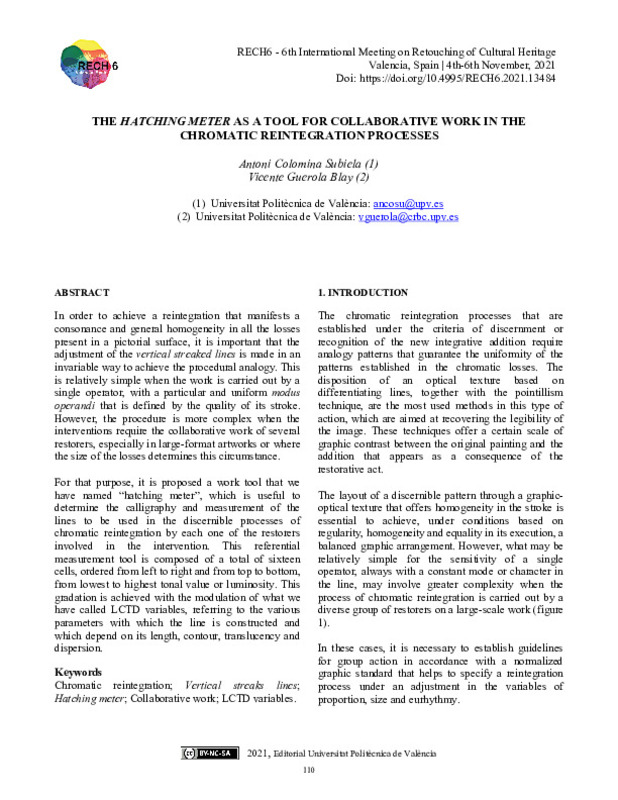JavaScript is disabled for your browser. Some features of this site may not work without it.
Buscar en RiuNet
Listar
Mi cuenta
Estadísticas
Ayuda RiuNet
Admin. UPV
The Hatching Meter as a Tool for Collaborative Work in the Chromatic Reintegration Processes
Mostrar el registro sencillo del ítem
Ficheros en el ítem
| dc.contributor.author | Colomina, Antoni
|
es_ES |
| dc.contributor.author | Guerola, Vicente
|
es_ES |
| dc.date.accessioned | 2023-01-18T13:16:49Z | |
| dc.date.available | 2023-01-18T13:16:49Z | |
| dc.date.issued | 2023-01-11 | |
| dc.identifier.isbn | 9788413960258 | |
| dc.identifier.uri | http://hdl.handle.net/10251/191390 | |
| dc.description.abstract | [ES] Para lograr una reintegración que manifieste una consonancia y homogeneidad general en todas las pérdidas presentes en una superficie pictórica, es importante que el ajuste de las líneas verticales rayadas se realice de forma invariable para lograr la analogía procedimental. Esto es relativamente sencillo cuando el trabajo lo realiza un único operario, con un modus operandi particular y uniforme que se define por la calidad de su trazo. Sin embargo, el procedimiento es más complejo cuando las intervenciones requieren el trabajo colaborativo de varios restauradores, especialmente en obras de gran formato o cuando el tamaño de las pérdidas determina esta circunstancia. Para ello, se propone una herramienta de trabajo que hemos denominado "medidor de sombreado", útil para determinar la caligrafía y medida de los trazos a emplear en los procesos discernibles de reintegración cromática por cada uno de los restauradores implicados en la intervención. Esta herramienta de medición referencial está compuesta por un total de dieciséis celdas, ordenadas de izquierda a derecha y de arriba abajo, de menor a mayor valor tonal o luminosidad. Esta gradación se consigue con la modulación de lo que hemos denominado variables LCTD, referidas a los distintos parámetros con los que se construye la línea y que dependen de su longitud, contorno, translucidez y dispersión. | es_ES |
| dc.description.abstract | [EN] In order to achieve a reintegration that manifests a consonance and general homogeneity in all the losses present in a pictorial surface, it is important that the adjustment of the vertical streaked lines is made in an invariable way to achieve the procedural analogy. This is relatively simple when the work is carried out by a single operator, with a particular and uniform modus operandi that is defined by the quality of its stroke. However, the procedure is more complex when the interventions require the collaborative work of several restorers, especially in large-format artworks or where the size of the losses determines this circumstance. For that purpose, it is proposed a work tool that we have named “hatching meter”, which is useful to determine the calligraphy and measurement of the lines to be used in the discernible processes of chromatic reintegration by each one of the restorers involved in the intervention. This referential measurement tool is composed of a total of sixteen cells, ordered from left to right and from top to bottom, from lowest to highest tonal value or luminosity. This gradation is achieved with the modulation of what we have called LCTD variables, referring to the various parameters with which the line is constructed and which depend on its length, contour, translucency and dispersion. | es_ES |
| dc.format.extent | 5 | es_ES |
| dc.language | Inglés | es_ES |
| dc.publisher | Editorial Universitat Politècnica de València | es_ES |
| dc.relation.ispartof | 6th International Meeting on Retouching of Cultural Heritage, RECH6 | |
| dc.rights | Reconocimiento - No comercial - Compartir igual (by-nc-sa) | es_ES |
| dc.subject | Reintegración cromática | es_ES |
| dc.subject | Medidor de eclosión | es_ES |
| dc.subject | Trabajo colaborativo | es_ES |
| dc.subject | Variables LCTD | es_ES |
| dc.subject | Chromatic reintegration | es_ES |
| dc.subject | Vertical streaks lines | es_ES |
| dc.subject | Hatching meter | es_ES |
| dc.subject | Collaborative work | es_ES |
| dc.subject | LCTD variables | es_ES |
| dc.title | The Hatching Meter as a Tool for Collaborative Work in the Chromatic Reintegration Processes | es_ES |
| dc.type | Capítulo de libro | es_ES |
| dc.type | Comunicación en congreso | es_ES |
| dc.identifier.doi | 10.4995/RECH6.2021.13484 | |
| dc.rights.accessRights | Abierto | es_ES |
| dc.contributor.affiliation | Universitat Politècnica de València. Departamento de Conservación y Restauración de Bienes Culturales - Departament de Conservació i Restauració de Béns Culturals | es_ES |
| dc.contributor.affiliation | Universitat Politècnica de València. Facultad de Bellas Artes - Facultat de Belles Arts | es_ES |
| dc.contributor.affiliation | Universitat Politècnica de València. Instituto Universitario de Restauración del Patrimonio - Institut Universitari de Restauració del Patrimoni | es_ES |
| dc.description.bibliographicCitation | Colomina, A.; Guerola, V. (2023). The Hatching Meter as a Tool for Collaborative Work in the Chromatic Reintegration Processes. En 6th International Meeting on Retouching of Cultural Heritage, RECH6. Editorial Universitat Politècnica de València. 110-114. https://doi.org/10.4995/RECH6.2021.13484 | es_ES |
| dc.description.accrualMethod | OCS | es_ES |
| dc.relation.conferencename | RECH6 - 6th International Meeting on Retouching of Cultural Heritage | es_ES |
| dc.relation.conferencedate | Noviembre 04-05, 2021 | es_ES |
| dc.relation.conferenceplace | Valencia, España | es_ES |
| dc.relation.publisherversion | http://ocs.editorial.upv.es/index.php/RECH/RECH6/paper/view/13484 | es_ES |
| dc.description.upvformatpinicio | 110 | es_ES |
| dc.description.upvformatpfin | 114 | es_ES |
| dc.type.version | info:eu-repo/semantics/publishedVersion | es_ES |
| dc.relation.pasarela | OCS\13484 | es_ES |








